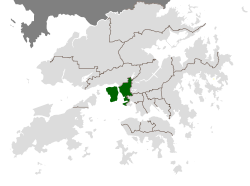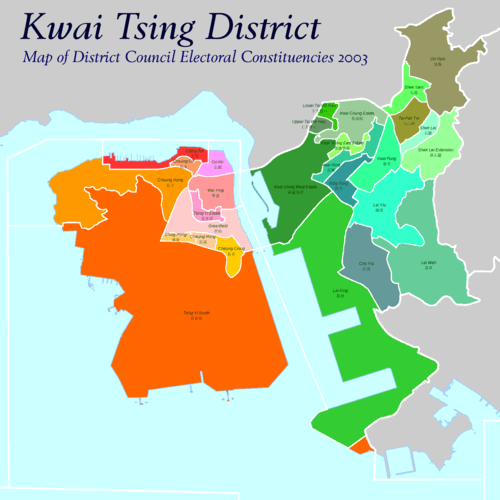Kwai Tsing District
| Kwai Tsing 葵青區 | ||
|---|---|---|
| District | ||
| Kwai Tsing District | ||
|
Night view of Kwai Tsing Container Terminals in the Kwai Tsing District | ||
| ||
 Location of Kwai Tsing within Hong Kong | ||
| Coordinates: 22°21′18″N 114°05′02″E / 22.35488°N 114.08401°ECoordinates: 22°21′18″N 114°05′02″E / 22.35488°N 114.08401°E | ||
| Country | Hong Kong | |
| Region | New Territories | |
| Constituencies | 29 | |
| Government | ||
| • District Council Chairman | Fong Ping (BPA) | |
| Area | ||
| • Total | 21.82 km2 (8.42 sq mi) | |
| Population (2006) | ||
| • Total | 523,300 | |
| • Density | 24,000/km2 (62,000/sq mi) | |
| Time zone | Hong Kong Time (UTC+8) | |
| Website | Kwai Tsing District Council | |
| Kwai Tsing District | |||||||||||||
| Traditional Chinese | 葵青區 | ||||||||||||
|---|---|---|---|---|---|---|---|---|---|---|---|---|---|
| |||||||||||||

Kwai Tsing (Chinese: 葵青區; Cantonese IPA: [kʰwɐi11 tsɪŋ55 kʰɵy55]; Hong Kong Hakka: kwi2 Ciang1 ki1; Putonghua Pinyin: Kuíqīng Qū) is one of the 18 districts of Hong Kong. It consists of two parts - Kwai Chung and Tsing Yi Island. Kwai Tsing is part of the New Territories. It had a population of 477,092 in 2001. The district has the third least educated residents and their income is below average.
Kwai Tsing did not exist as a standalone district when Hong Kong's District Boards were formed in the early 1980s. It remained as a part of Tsuen Wan district until 1985. The newly created district was known as Kwai Chung and Tsing Yi District (葵涌及青衣區) until 1988, when its name was shortened to Kwai Tsing District.
The internationally famous container terminals can be found within the district, along the shores of Rambler Channel between Kwai Chung and Tsing Yi Island. The Tsing Ma Bridge, leading to the Hong Kong International Airport through the North Lantau Highway, starts at the northwestern end of Tsing Yi Island.
Over 75% of the district residents live in public housing.
History
During the eighth year of Emperor Kangxi (1669), the Qing Government forced the Hong Kong and the coastal regions such as Guangdong, Guangxi, Fujian, etc., to move to the inland areas of mainland China. After this move inland policy ceased, a large number of Hakka people in this period China moved to the new County and southeast coastal areas. Kwai Tsing District is traditionally speak Hakka areas, because the original inhabitants of the villages in this area mainly in Hakka Family. "Kwai" was first seen in a Ming Guo fei compiled the "big mind Guangdong, Guangdong coastal map" within the same diagram "Kwai" next to the name of an island "spring flowers", now there is a south-east Tsing Yi Island small mountain known as spring flowers, believes that "spring flowers" is the ancient name "Tsing" is. "Territories village official Fu Company" Qing Dynasty Emperor Kangxi compiled by Wang Tsung-hee "in Xin'an County Metropolitan" in the records there, "Chung child" and "Tsing Yi".
Geography
Kwai Tsing District borders in the north and west with Tsuen Wan District, east with Sha Tin District, southeast with Sham Shui Po District and Yau Tsim Mong District (marine), south with Central and Western District (marine), and southwest with Islands District (marine).
Constituencies
2003
By 2003 District Councils Election, the Kwai Tsing District Council is divided into 28 constituencies:
Kwai Chung
- Cho Yiu
- Kwai Chung Estate
- Kwai Fong
- Kwai Hing
- Kwai Shing East Estate
- Kwai Shing West Estate
- Hing Fong
- Lai King
- Lai Wah
- Lai Yiu
- On Yam
- Shek Lei
- Shek Lei Extension
- Shek Yam
- Tai Pak Tin
- Upper Tai Wo Hau
 Constituencies in 2003 District Council Election.
Constituencies in 2003 District Council Election. - Lower Tai Wo Hau
Tsing Yi
- Cheung Ching
- Cheung Hang
- Cheung Hong
- Cheung On
- Ching Fat
- Greenfield
- On Ho
- Shing Hong
- Tsing Yi Estate
- Tsing Yi South
- Wai Ying
1994
etc.
Town centre
The district is part of Tsuen Wan New Town. Unlike other new towns in Hong Kong, the district has no clear town core in the course of development. Cores emerge only after Metroplaza in Kwai Fong and Maritime Square in Tsing Yi was built, but they are still incomparable to their counterparts in other new towns in Hong Kong.
Industry
Industry is an integral part of the district. Both light and heavy industries share substantial land in the district.
Basic education
Like other early new towns of Hong Kong, the district was primary for settling the influx of Chinese population around the year of the change of sovereignty in China in 1949 and the baby boom afterwards. Public housing estates were built throughout the district. Many schools have been established by various charities and religious organisations. Some have provided vocational training for industries in Hong Kong while some have become liberal schools. As the community has aged, the number of school children declined after the 2000s, and schools are facing survival problems.
Secondary schools in 2006:
- Buddhist Sin Tak College
- Buddhist Yip Kei Nam Memorial College
- Caritas St. Joseph Secondary School
- Carmel Alison Lam Foundation Secondary School
- CCC Chuen Yuen College
- CCC Yenching College
- CNEC Christian College
- CNEC Lee I Yao Memorial Secondary School
- Cotton Spinners Association Secondary School
- Daughters of Mary Help of Christians Siu Ming Catholic Secondary School
- Ha Kwai Chung Government Secondary School
- HKSYC & IA Chan Nam Chong Memorial College
- Hong Kong Taoist Association the Yuen Yuen Institute No.1 Secondary School
- Ju Ching Chu Secondary School (Kwai Chung)
- Kiangsu-Chekiang College (Kwai Chung)
- Kwai Chung Methodist College
- Lai King Catholic Secondary School
- Lingnan Dr Chung Wing Kwong Memorial Secondary School
- Lions College
- Lok Sin Tong Ku Chiu Man Secondary School
- Lok Sin Tong Leung Chik Wai Memorial School
- Po Leung Kuk Lo Kit Sing (1983) College
- Pope Paul VI College
- Queen's College Old Boys' Association Secondary School
- Salesians of Don Bosco Ng Siu Mui Secondary School
- Shek Lei Catholic Secondary School
- Sheung Kwai Chung Government Secondary School
- Shun Tak Fraternal Association Lee Shau Kee College
- Sheng Kung Hui Lam Woo Memorial Secondary School
- The Methodist Lee Wai Lee College
- Tung Wah Group of Hospitals Chen Zao Men College
- Tung Wah Group of Hospitals Mrs Wu York Yu Memorial College
- Tung Wah Group of Hospitals S. C. Gaw Memorial College
Transport
The usual forms of transportation in the district are buses, minibuses and metro.
The MTR (metro) Tsuen Wan Line has four stations on three lines running through the district:
- Lai King is the southernmost, and the interchange between Tsuen Wan and Tung Chung lines.
- The Tsuen Wan Line then runs through two stations (Kwai Fong, Kwai Hing) before exiting the district for Tsuen Wan.
- Tung Chung Line diverges to the west to Tsing Yi Island and have a station, Tsing Yi, there.
- Tsing Yi Station is also served by Airport Express, which is the last station before reaching the Airport.
- Bus
- KMB:30,31,31B,32,32M,33A,34,35A,36A,36B,36M,37,37M,38,38A,40,40X,41,41A,42,42A,42C,42M,43,43A,43B,43C,43M,44,44M,45,46,46X,47X,48X,49X,57M,58M,59A,61M,67M,68A,68E,69M,73X,235,235M,243M,248M,249M,265M,269M,278X,279X
- Long Win Bus:A31,E31,E32
- Citybus:E21,930, 930A, 930X
Leisure
There are several sports grounds in the district. Biu Chun Rangers are based in Tsing Yi. Kwai Tsing Theatre in Kwai Fong is gradually becoming an important performance venue in Hong Kong.
See also
External links
- Kwai Tsing District Council
- Tsuen Wan New Town
- List and map of electoral constituencies (large PDF file)
 |
Tuen Mun District | Tsuen Wan District | Sha Tin District |  |
| |
||||
| ||||
| | ||||
| Islands District | Central and Western District | Sham Shui Po District |

